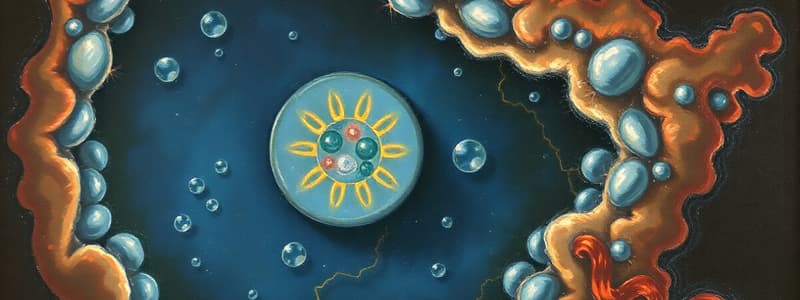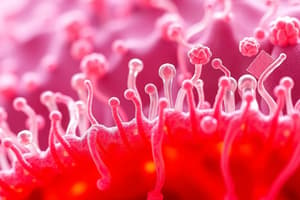Podcast
Questions and Answers
What is the main function of the plasma membrane?
What is the main function of the plasma membrane?
- To synthesize proteins
- To store genetic information
- To produce energy for the cell
- To regulate the movement of substances into and out of the cell (correct)
What type of molecule forms the hydrophobic center of the phospholipid bilayer?
What type of molecule forms the hydrophobic center of the phospholipid bilayer?
- Phosphates
- Carbohydrates
- Fatty acids (correct)
- Proteins
Which of these is NOT a function of membrane proteins?
Which of these is NOT a function of membrane proteins?
- Transport of molecules
- Energy production (correct)
- Cell signaling
- Structural support
What is the main role of histones in DNA packaging?
What is the main role of histones in DNA packaging?
Which form of chromatin is actively involved in transcription?
Which form of chromatin is actively involved in transcription?
Which of the following factors is NOT involved in the initiation stage of protein synthesis?
Which of the following factors is NOT involved in the initiation stage of protein synthesis?
During elongation, where does the next amino acid attach to the growing polypeptide chain?
During elongation, where does the next amino acid attach to the growing polypeptide chain?
What is the role of a stop codon in protein synthesis?
What is the role of a stop codon in protein synthesis?
Which of the following is NOT a potential post-translational modification of a polypeptide chain?
Which of the following is NOT a potential post-translational modification of a polypeptide chain?
What is the main function of DNA?
What is the main function of DNA?
Which of these is NOT a known destination of proteins?
Which of these is NOT a known destination of proteins?
What is the difference between a gene and a genome?
What is the difference between a gene and a genome?
What is the process of translating genetic information into a protein called?
What is the process of translating genetic information into a protein called?
What is the relationship between a codon and an amino acid?
What is the relationship between a codon and an amino acid?
What is the role of tRNA in protein synthesis?
What is the role of tRNA in protein synthesis?
Which of these is NOT a way that the proteome is more complex than the genome?
Which of these is NOT a way that the proteome is more complex than the genome?
Which of these is NOT a way in which protein synthesis can be regulated?
Which of these is NOT a way in which protein synthesis can be regulated?
What is a common feature of proteins that will be directed to the endoplasmic reticulum, Golgi complex, secretory vesicles, plasma membrane, or lysosomes?
What is a common feature of proteins that will be directed to the endoplasmic reticulum, Golgi complex, secretory vesicles, plasma membrane, or lysosomes?
How can proteins be modified after translation?
How can proteins be modified after translation?
What determines the final location of a protein within a cell?
What determines the final location of a protein within a cell?
What is the role of a promoter in protein synthesis?
What is the role of a promoter in protein synthesis?
What is the purpose of splicing in pre-mRNA processing?
What is the purpose of splicing in pre-mRNA processing?
What role do transcription factors play in protein synthesis?
What role do transcription factors play in protein synthesis?
What is the main function of RNA polymerase in transcription?
What is the main function of RNA polymerase in transcription?
Which of the following is involved in the translation process? (Select all that apply)
Which of the following is involved in the translation process? (Select all that apply)
What is the role of the A site in a ribosome during translation?
What is the role of the A site in a ribosome during translation?
What happens during the termination stage of transcription?
What happens during the termination stage of transcription?
Which of the following describes what may happen in RNA interference?
Which of the following describes what may happen in RNA interference?
Flashcards
Heterochromatin
Heterochromatin
Inactive regions of DNA that are highly condensed.
Gene
Gene
A DNA sequence that codes for a specific amino acid sequence or RNA.
Genome
Genome
The total genetic information in the DNA of a typical cell.
Transcription
Transcription
Signup and view all the flashcards
Codon
Codon
Signup and view all the flashcards
Plasma Membrane
Plasma Membrane
Signup and view all the flashcards
Fluid-Mosaic Model
Fluid-Mosaic Model
Signup and view all the flashcards
Integral Proteins
Integral Proteins
Signup and view all the flashcards
Euchromatin
Euchromatin
Signup and view all the flashcards
Histones
Histones
Signup and view all the flashcards
Leader Sequence
Leader Sequence
Signup and view all the flashcards
Rough ER Role
Rough ER Role
Signup and view all the flashcards
Proteome
Proteome
Signup and view all the flashcards
Posttranslational Modification
Posttranslational Modification
Signup and view all the flashcards
Regulation of Protein Synthesis
Regulation of Protein Synthesis
Signup and view all the flashcards
Initiation of Translation
Initiation of Translation
Signup and view all the flashcards
Elongation in Translation
Elongation in Translation
Signup and view all the flashcards
Termination of Translation
Termination of Translation
Signup and view all the flashcards
Chaperone Proteins
Chaperone Proteins
Signup and view all the flashcards
mRNA
mRNA
Signup and view all the flashcards
Promoter
Promoter
Signup and view all the flashcards
Exons and Introns
Exons and Introns
Signup and view all the flashcards
Splicing
Splicing
Signup and view all the flashcards
tRNA
tRNA
Signup and view all the flashcards
Ribosome
Ribosome
Signup and view all the flashcards
Translation
Translation
Signup and view all the flashcards
Study Notes
Cell Structure: Plasma Membrane and Protein Synthesis
- Cells have a plasma membrane, a selective barrier.
- Phospholipid bilayer forms the core forming a hydrophobic barrier
- Phosphate heads interact with water.
- Fatty acid tails are hydrophobic.
- Proteins and phospholipids move laterally within the membrane.
- Fluid mosaic model describes the dynamic nature.
- Membrane proteins allow selective passage of substances.
A Typical Cell Components
- Nucleus: Contains DNA, controls cell activities.
- Nucleolus: Site of ribosome production.
- Rough endoplasmic reticulum (RER): Ribosomes attached, processes proteins.
- Smooth endoplasmic reticulum (SER): Lacks ribosomes, synthesizes lipids.
- Golgi apparatus: Modifies, sorts, and packages proteins.
- Mitochondria: Powerhouse of the cell, produces ATP.
- Lysosomes: Contain enzymes, break down waste.
- Ribosomes: Responsible for protein synthesis.
- Centrioles: Involved in cell division
- Secretory vesicles: Transport molecules outside the cell.
- Microtubules: Part of the cytoskeleton, maintain cell shape.
DNA in the Nucleus
- Chromatin: DNA is packaged with proteins (histones).
- Histones: Positively charged proteins, interact with negatively charged DNA.
- Euchromatin: Active in transcription, less condensed.
- Heterochromatin: Inactive regions, highly condensed.
Genetic Code & Protein Synthesis
- DNA directs protein synthesis
- Gene: DNA sequence coding for a protein or mRNA.
- Genome: Total genetic information in a cell. Human genome ~25,000 genes.
- DNA triplets (codons) code for specific amino acids.
- Genetic code is universal.
Basic Steps of Protein Synthesis
- DNA is transcribed into mRNA in the nucleus.
- mRNA moves to the cytoplasm.
- mRNA is translated into protein by ribosomes.
Protein Synthesis: Transcription
- Transcription is DNA-directed RNA synthesis.
- mRNA is synthesized from a DNA template.
- mRNA carries the genetic code from DNA to the ribosomes.
- Steps of transcription include initiation, elongation, and termination.
- RNA polymerase binds to a promoter region in DNA.
- Elongation involves addition of complementary RNA bases to the template strand.
- Termination occurs at a stop codon.
- Pre-mRNA needs modification before translation.
Pre-mRNA modification
- Removal of introns.
- Addition of a 5' cap and a 3' poly-A tail.
- Alternative splicing.
- Splicing of introns to generate mature mRNA.
RNA Interference
- Some RNA molecules can block translation or destroy specific mRNA molecules
- Silences genes, blocking protein synthesis.
Protein Synthesis: Translation
- Ribosomes are complex particles
- mRNA binds to the ribosome.
- tRNA brings amino acids to the ribosome.
- Enzymes catalyze peptide bond formation between amino acids.
- The polypeptide chain grows until the stop codon is reached.
Ribosome
- Complex structure made of two subunits (small and large).
- Three sites for tRNA binding: A site, P site, E site.
- Ribosomes are responsible for linking amino acids together to form polypeptide chains.
Protein Synthesis: Translation Steps
- Initiation: Initiation factors, small subunit, initiator tRNA, large subunit form complex at start codon.
- Elongation: tRNA brings amino acids, peptidyl transferase links them, ribosome moves.
- Termination: Stop codon, polypeptide released.
Post-translational Modifications
- Chaperones help proteins fold correctly.
- Cleavage, addition of lipids or carbohydrates, methylation, phosphorylation.
- Protein modification can affect protein functionality and destination.
Destination of Proteins
- Proteins are targeted to specific compartments within the cell.
- Leader sequences direct protein's destination.
- Proteins ending up in cytoplasm, organelles (mitochondria, etc), or secreted from the cell.
- Proteins are transported throughout or out of the cell.
- proteins travel using transport vesicles.
Role of Rough ER in Protein Synthesis
- Ribosomes on RER synthesize proteins.
- Proteins enter RER lumen for processing.
- RER directs protein processing, folding and transport.
- Proteins can be packaged or become membrane proteins for insertion into the cellular membrane or transported outside of the cell.
Proteome
- Proteome refers to all proteins expressed by a cell or organism at a given time.
- The proteome's composition is dynamic and regulated based on a variety of factors (environmental and internal).
- Proteins can be modified
- Post-translational modifications
- Protein modification can impact protein function and fate.
Major Regulation of Protein Synthesis
- Transcriptional regulation.
- Translational regulation
- Factors affecting protein synthesis efficiency.
Regulation of Protein Synthesis
- Regulation of protein synthesis occurs at various points in the process.
- Various mechanisms used to turn genes on and off, and enhance or limit protein synthesis as needed.
Studying That Suits You
Use AI to generate personalized quizzes and flashcards to suit your learning preferences.




